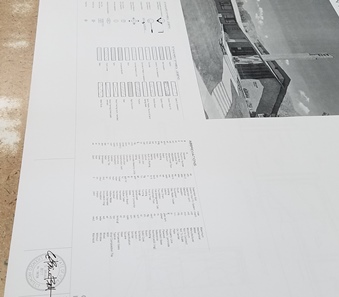We get asked a lot about the “best” paper and print for construction job site printing, and there are a few things that make this process of choosing paper and printing easy by asking 3 simple questions.
- 1. What is the print to be used for (job site trailer, overlays, estimating, etc)?
- 2. How long does it need to last (1 week, 3 months, forever)?
- 3. How good does it need to look?
Let’s handle the first question. Consider the environment where the print is going to be used. If it is in a place that has a lot of dirt and dust, where liquids are present, or where there is a lot of wear and tear by a lot of handling, this should play into your choice. Estimating, planning, and general examination mean that 20# paper is just fine for printing your prints. The ink on the paper is done with laser printing, and for most applications where the prints are inside and handled relatively lightly, a low-cost, high quality print on regular paper (20#) works really well for construction plans and drawings.
Now, let’s say that these prints are on the construction job site in October in Boston. The weather is unpredictable, the crews are rushing to finish before winter, and there is a lot of wet weather. In this scenario, 20# paper will disintegrate. The HVAC, plumbing, and electrical crews all need to take the plans to the actual installation point. The paper shreds, and the job is delayed or the notes on it are lost. For this purpose, Tyvek is a much better option. It is water proof, weather proof, spill proof, and you can just wash it off when it gets muddy. Now, the plans and notes stay intact, the project managers are happy, and the crews are happy. One or two job site sets on Tyvek will save hours of time and will last the entire job.
The second question is a little more vague. It is about durability as well, but if the plans are a customer set, they may be stored forever in paper form. So consider the use and the length of time that it needs to last. We found the perfect example for a larger fabricator and machine shop. They were printing out reams of paper for important templates and engineering drawings. The shop floor had metal shavings and lots of hands had to touch the drawings. Regularly, they would have to print out another set of drawings, since the paper would just shred. Mylar (film) works best in these cases. it is semi-rigid, has a long, long life, and is semi-transparent so the drawings could overlay on changes on paper. It was the perfect solution.
The third question is how does it need to look. For people who are bidding on jobs, giving presentations, or working directly with the customer, a nice set of construction plans are critical, especially when you want them in color. For color prints, there is a general rule of thumb: the higher the number on the paper, the thicker it is. Example: 20# paper is relatively light-weight, good for carrying around but doesn’t do well with color prints, while 24# is heavier and thicker, let’s less light through, and renderings look great. Presentation paper (32# paper) is really wonderful for blocking almost all back lighting and shows colors in their truest form, but it is really heavy for plans… so use it sparingly for renderings or color pictures.
Don’t hesitate to give us a call at 888.507.1002 if you have any question about what paper to choose for printing construction plans, renderings, blueprints, presentations, posters, or specifications (spec) books.


Do you provide samples?
Tyvek, and vellum
If so,
Po box 8451
Greenville tx 75404
Hi Johnny, we can provide a small Tyvek sample to you, so look for that soon. We don’t have vellum samples at this time.